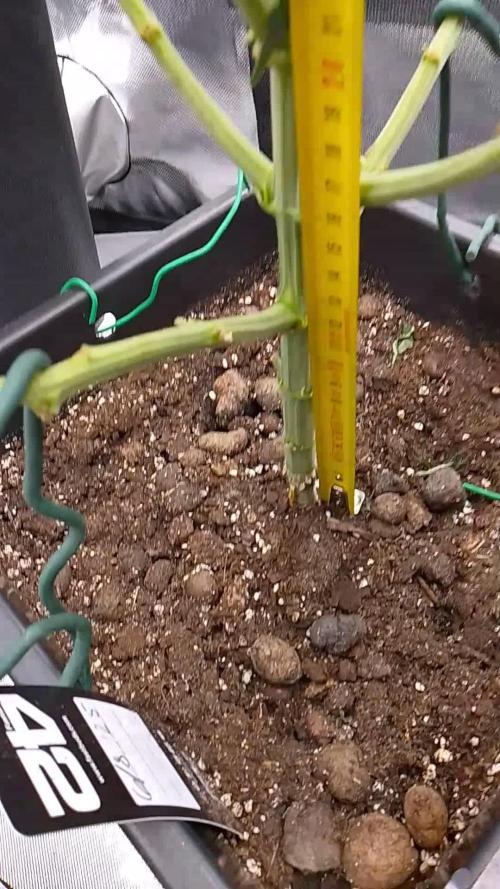The Grow Awards 2026 🏆 

































Processing
Likes
Comments
Share


@Stkz420
Follow
1 sour livers is smelling sweet and lemony other 1 smelling like a zesty liver🤔. Cant quite put my finger on the aroma coming from the northern hog but shes possibly in the best condition she ever has been.
Likes
6
Share


@Cannabis4Crohns
Follow
I've unshackled the plant by removing the ties I was using for LST. She continues to streach while producing new flowering sites.
I've decreased the Nitrogen and increased the Phosphorus and Potassium ratios in the feed.
Now watering 2 litres of water every 3/4 days.
Likes
2
Share


@UnderTrappen
Follow
She is still growing and seems happy and healthy..Went into flower yesterday after a month to the date. Lets see. This plant has surprised me a lot. Have two similar, neither going anywhere. This one is the exception hopefully.
Currently also moving to a tent. New ventilation etc.
The yellow tint to the leaves is due to my camera
This is last day Week 4. Literally grew 5cm overnight. Preflowering
Likes
68
Share


@Ferenc
Follow
So beautiful.....
Full fertilization started with the mix above the epsom salt is granulated so those little white balls are the epsom salt :) The little dried clementine is just decoration ;)
Likes
62
Share


@balansa
Follow
i think mexican airlines is ready for flushing. i will flush her next week smell and aroma is wonderful nore like skunky. moby dick has 2-3 weeks left i think she has more sweet smell. i wanna tell you the smth i know that its unwrighten rule that u should not touch the plant before harvest but i smoked both and they are impressive ))))
Likes
14
Share


@eldruida_lamota
Follow
Vamos familia cuarta semana de vida de estás Tropical Zmoothie de SeedStockers.
Que ganas tengo de ver el progreso de esta variedad, las plantulas están sanas, se ven con buen color.
La cantidad de agua cada 48h entre riegos.
Esta primera semana ya añadimos nutrientes de la gama Agrobeta.
Tuve problemas de trips en un indoor y tengo todas plagadas pero ya las e tratado con aceite de neem y un insecticida genérico, además añadí varias tiras de color azul, trataré esta semana y la siguiente.( pronto llega aceite de neem y jabón potásico para terminar con ella)
También realicé el trasplante a maceta definitiva, 7 litros.
Estas próximas semanas veremos cómo avanzan.
Mars hydro:
Code discount: EL420
https://www.mars-hydro.com/
Agrobeta:
https://www.agrobeta.com/agrobetatiendaonline/36-abonos-canamo
Hasta aquí todo, Buenos humos 💨💨.
Likes
8
Share


@Cannabot
Follow
Smells amazing, looks amazing just a beauty of a plant tbh...drinking loads but I'm just sticking to ppm for now with slightly increasing bloom boost every feed
Likes
2
Share


@Cannabot
Follow
Love the blueberry strains,they have that smell that is unique to them.Really looking forward to blazing on this bad girl.Buds are getting nice and fat off all the bloom and light. Last bloom feed and then flush
Likes
225
Share


@The_Projexx
Follow
This marks the start of week 4 for these wonderful lady's . I'm going to be slowing up on the nutrients and the watering noticing some stuff I don't like seeing . For the growth difference in 1 week all I can say is WOW I'm getting very excited to see what the future holds for these young lady's !!! I'd like to thank every one for their continued support! I've learned so much in such a short amount of time because the community is KICK ASS . I'm going to be repotting these fine young lady's into their final homes at the end of this week! Stay tuned ladies and gentlemen alike and remember to check my diaries daily for updates !
Anyone checking out the pictures it isn't mites or any of that I been having a battle to get them to my standard of clean since the transplant. Slow and gentle is the way so no damages are done ! :)
-Happy Growing!
Likes
32
Share


@biggreens420
Follow
bubbas doing well fading out and she smells kind of earthy berry at this point it's nice she's getting covered in trichs and some nice colours coming through on the buds . removed faded leaves as they fade and she's nice and sticky when touching will be giving a feed with bactrex 1g into 1l to help use what's left in the soil thanks for reading happy growing guys
Processing
Likes
21
Share


@LittleBigTrees
Follow
Been feeding just water ready for the chop.
Some of them have all brown pistils and have pretty much stopped all together.
The kalimist indica pheno is still flowering so I'll let it go until it looks ripe 👍
Processing
Likes
12
Share


@Silverback_Guerilla
Follow
7/6:
Heavy thunderstorms last night and half the day today, so they won't be ready to eat again for a few days. I went out to the site about an hour after it quit raining today and saw HUNDREDS of tiny little green grasshoppers feasting on my girls!!! I immediately sprayed them all down with pyrethrins, and did it again right before dark.
I've got the fan blowing across the pots to try to dry them out faster.
I started using TPS One (one part nute solution) the other day, and the plants seem to love it. Really growing well, but I'm glad I amended their soil with some happy frog fruit and flower granular fertilizer this time. They get fed whether it's too wet or not.
7/7:
Sprayed for grasshoppers again this morning...hungry little fuckers...👺
It was a very cloudy day...but these girls are also just a couple of feet beneath 470w of 3000k LED's all day/every day, so it's always sunny.😎
Likes
116
Share


@Kitties_and_Colas
Follow
~_~_~_~_~_~_~_~_~_~_~_~_~_~_~_~_~_~_~_~_~_~_~_~_~_~_~_~_~_~_~_~_~_~_~_~_~_~_~_~_~_~_~_~_~_~_~_~_~_~_~_~_~_~_~_~_~_~_~_~_~_~_~_~_~_~_~_~_~_~_~_~_~_~_~_~_~_~_~_~_~_~_~_
12/26
😻We're almost there! We started our preharvest flush last week and color is fading fast.. one plant from the group was ready (she's drying now) that plant has been ahead of the bunch this entire time..the rest of the girls should be ready to come down by next week but we're watching trichs close just in case they turn fast..The SP-3000 by MarsHydro has been an amazing addition to the grow room, our clones and seedlings couldn't be happier..It took some trial, error and a few burnt tips to dial in distance but I'm very happy we've found the perfect spot in time for a decent harvest this round but our upcoming Bruce Banger grow will be absolutely epic!! Thanks as always for the love and support, happy harvests everyone!!
⚡Mars Hydro/SP-3000⚡ Specifications ⚙️:
Diodes: Samsung LM301B / Osram 660nm (960 total!)
Driver: Meanwell 300watt 🔌 (300W±5% @AC120V-277V)
PPF: 824umol/S ☢️
PPE: 2.8 µmol/j 〰️〰️
Lifespan: >50k hrs ⌛
Veg Coverage: 3 x 5 ft 🌱
Flowering Coverage: 2 x 4 ft 🌼
Weight: 10.1 lbs (4.6kg)
-The SP-3000 uses an aluminum heatsink (no fan) and the driver can be placed outside the tent 🌡️⬇️
-IP65 waterproof ratings, tolerant to high humidity grow environments 💦 ..
-Up to 15 can be daisy-chained together and all controlled from a single light! 💡~💡~💡~💡~💡
~_~_~_~_~_~_~_~_~_~_~_~_~_~_~_~_~_~_~_~_~_~_~_~_~_~_~_~_~_~_~_~_~_~_~_~_~_~_~_~_~_~_~_~_~_~_~_~_~_~_~_~_~_~_~_~_~_~_~_~_~_~_~_~_~_~_~_~_~_~_~_~_~_~_~_~_~_~_~_~_~_~_~_
12/28
This is some potent bud lol..I made a tincture with the plant we cut down a few days ago and it's a chemical weapon lol...the smoke is amazing too, these buds are completely covered in crystals, they just melt in the pipe and this stuff gives me a slight head rush .. we might chop the rest down later today❤️🌱
😽💨
~_~_~_~_~_~_~_~_~_~_~_~_~_~_~_~_~_~_~_~_~_~_~_~_~_~_~_~_~_~_~_~_~_~_~_~_~_~_~_~_~_~_~_~_~_~_~_~_~_~_~_~_~_~_~_~_~_~_~_~_~_~_~_~_~_~_~_~_~_~_~_~_~_~_~_~_~_~_~_~_~_~_~
Likes
71
Share


@Roberts
Follow
Blue Dream Extreme has been doing good since the over stretching. Roots are finding the solution now. I am growing her under a Spider Farmer SE5000. Growing her in a New Level Hydro 5 gallon bucket links below. Thank you Spider Farmer, New Level Hydro, and Amsterdam Marijuana Seeds. 🤜🤛🌱🌱🌱
SE5000
https://amzn.to/3qFpAML
Spider Farmer Official Website Links:
US&Worldwide: https://www.spider-farmer.com
UK: https://spiderfarmer.co.uk
CA: https://spiderfarmer.ca
EU: https://spiderfarmer.eu
AU: https://spiderfarmer.com.au
Coupon Code: saveurcash
Thank you grow diaries community for the 👇likes👇, follows, comments, and subscriptions on my YouTube channel👇. ❄️🌱🍻 Happy Growing 🌱🌱🌱
https://youtube.com/channel/UCAhN7yRzWLpcaRHhMIQ7X4g
www.newlevelhydro.com
www.hygrozyme.com
Processing
Likes
17
Share


@leliantu
Follow
41 días desde el cambio de fotoperiodo. Al parecer en mi celo por evitar una sobre fertilización provoque carencia de nutrientes, o mejor dicho, las plantas estaban pasando hambre. Durante esta semana las hojas pequeñas y grandes empezaron a amarillear por lo que subí las dosis de fertilizante y la EC hasta 1.1 (me había mantenido en máximo de 0.8), las plantas reaccionaron bien y se noto el cambio en el tamaño de las flores. En las próximas semanas aumentare la EC hasta 1.5.
Processing
Likes
5
Share


@Mr_nugs_lover_David
Follow
Very good looking just like her sister, powerful citric and sweet aroma, very good strain, and starting to smell seriously at the start of 2nd week I'm noticing the same thing on both plants! Awesome strain
Likes
60
Share


@Drgreenthumb627
Follow
This one took a longggg time to finish, i ended ip harvesting at the end of 11 weeks. the best way to describe the end smell is grape and pinesol, its very aromatic even at 3 weeks post harvest. incredible terpene profile



























